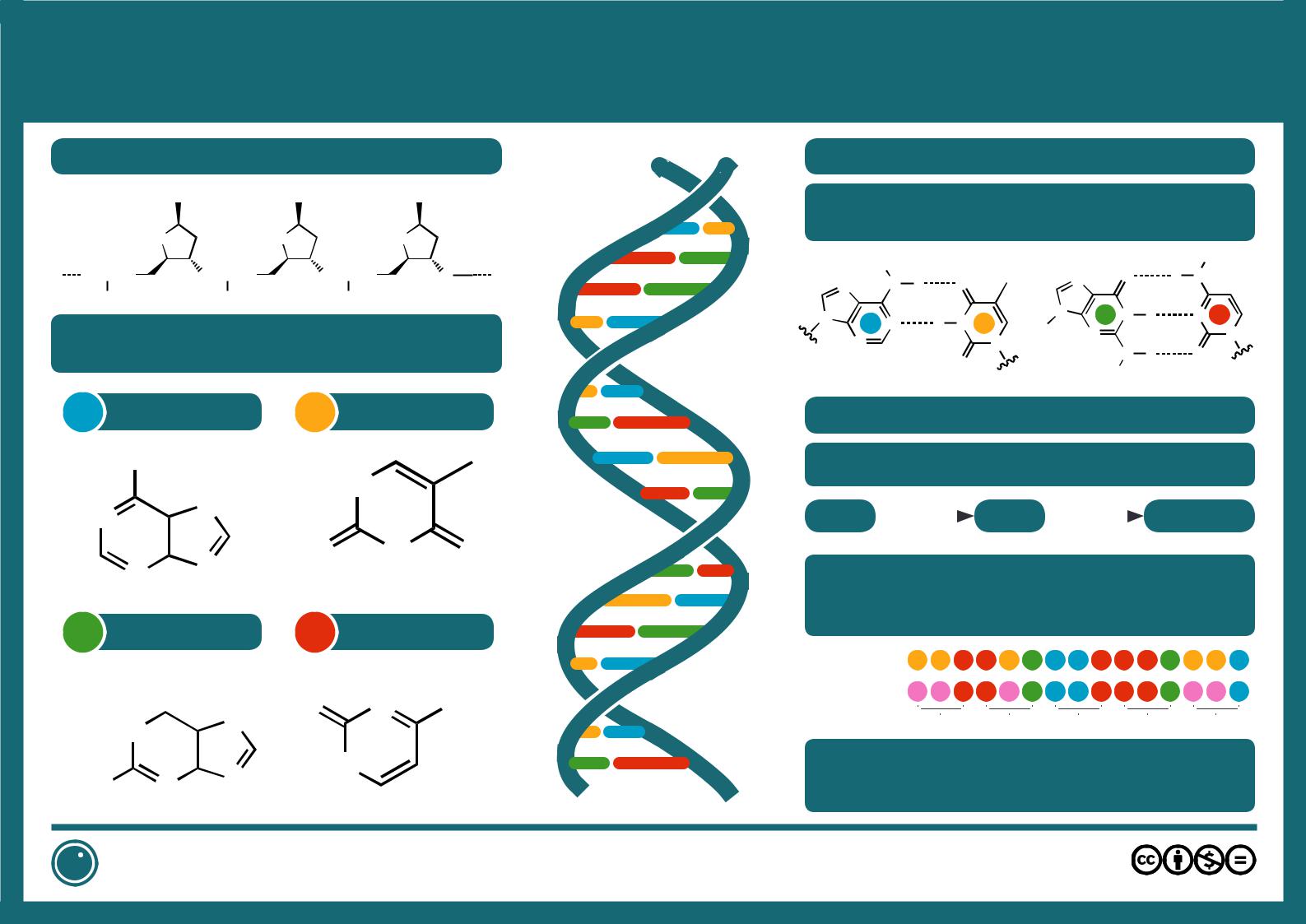
ДНК-нанотехнологии 1 введение и основные методы / The-Chemical-Structures-of-DNA-RNA-Aug-2018
.pdf
THE CHEMICAL STRUCTURE OF DNA
THE SUGAR PHOSPHATE ‘BACKBONE’
|
|
|
|
|
|
BASE |
BASE |
BASE |
||||||||||||
|
|
|
|
|
|
O |
O |
O |
||||||||||||
O |
|
O |
|
O |
|
|||||||||||||||
|
|
|
|
|
O |
O |
|
|
|
|
|
|
|
|
|
|
|
|
|
|
|
P |
|
|
P |
|
O |
O |
|
P |
|
O |
O |
||||||||
|
|
|
|
|
|
|||||||||||||||
O- |
|
O- |
|
O- |
|
|||||||||||||||
DNA is a polymer made up of units called nucleotides. The nucleotides are made of three different components: a sugar group, a phosphate group, and a base. There are four different bases: adenine, thymine, guanine and cytosine.
A |
ADENINE |
T |
THYMINE |
||||||
|
NH2 |
|
H |
HN |
|
||||
|
|
|
|
|
|
||||
N |
|
|
|
|
N |
|
|
|
|
|
|
|
|
N |
O |
N |
O |
||
|
|
|
|
|
|||||
|
N |
|
|||||||
|
|
|
H |
|
|||||
G |
GUANINE |
C |
CYTOSINE |
||||||
|
O |
|
H |
O |
N |
NH2 |
|||
|
|
|
|
|
|||||
|
|
|
|
|
N |
||||
HN |
|||||||||
|
N |
HN |
|
|
|||||
H2N |
N |
|
|
|
|||||
|
|
|
|||||||
|
|
|
|
||||||
WHAT HOLDS DNA STRANDS TOGETHER?
DNA strands are held together by hydrogen bonds between bases on adjacent strands. Adenine (A) always pairs with thymine (T), while guanine (G) always pairs with cytosine (C). Adenine pairs with uracil (U) in RNA.
H H N N H O N O H N
N A H T  N G H C
N G H C
O N H O H
FROM DNA TO PROTEINS
The bases on a single strand of DNA act as a code. The letters form three letter codons, which code for amino acids - the building blocks of proteins.
DNA |
|
RNA |
|
PROTEIN |
|
|
|||
|
|
|||
|
TRANSCRIPTION |
TRANSLATION |
||
An enzyme, RNA polymerase, transcribes DNA into mRNA (messenger ribonucleic acid). It splits apart the two strands that form the double helix, then reads a strand and copies the sequence of nucleotides. The only difference between the RNA and the original DNA is that in the place of thymine (T), another base with a similar structure is used: uracil (U).
DNA SEQUENCE |
T T C |
C |
T |
G |
A |
A |
C |
C |
C |
G |
T |
T |
A |
mRNA SEQUENCE |
U U C |
C U G |
A |
A |
C |
C C |
G |
U |
U |
A |
|||
AMINO ACID |
Phenylalanine |
Leucine |
|
Asparagine |
|
Proline |
|
|
Leucine |
|
|||
In multicellular organisms, the mRNA carries genetic code out of the cell nucleus, to the cytoplasm. Here, protein synthesis takes place. ‘Translation’ is the process of turning the mRNA’s ‘code’ into proteins. Molecules called ribosomes carry out this process, building up proteins from the amino acids coded for.
Ci |
© Andy Brunning/Compound Interest 2018 - www.compoundchem.com | Twitter: @compoundchem | FB: www.facebook.com/compoundchem |
This graphic is shared under a Creative Commons Attribution-NonCommercial-NoDerivatives licence. |
BY NC ND
